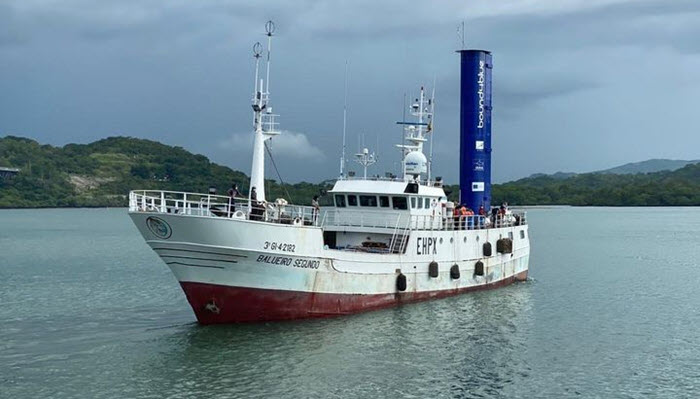
We see them, we need them, but what are they doing to the planet? Maybe sailing can come to the rescue. In this report by The Big Idea, the Spanish startup bound4blue is reinventing the sail to make the shipping industry more sustainable:
If the shipping industry was a country, it would be the sixth-most polluting in the world — just ahead of Germany. And despite the industry’s dubious environmental credentials, 90% of global cargo is still shipped by sea.
Cristina Aleixendri, a Spanish aerospace engineer, thinks the age-old sail is the way to cut shipping pollution.
“The Pheonicians traveled around the world with sails; but the industry left behind that technology because it wasn’t suitable — it wasn’t economically viable,” she says.
But society’s moved on since the Pheonicians’ time, so Aleixendri and her co-founders at bound4blue, based in Barcelona, decided to make a sail efficient enough for the shipping companies of the 21st century.
The first boat to use a bound4blue sail set off from Panama last month.
What problem does it solve?
There are 80k vessels navigating the world today, and the fuel they use contains a lot of pollutants and produces carbon dioxide.
A 2020 International Maritime Organization regulation change forced all vessels to use ‘marine gas oil’ rather than heavier fuel oils. Before the change, the 16 largest boats in the ocean were producing more sulfur than all the cars in the world. The new fuel is slightly less polluting, but it’s in no way perfect because it still requires fossil fuels.
It’s also a lot more expensive for shipping companies, who are already struggling with costs. Fuel is the industry’s single largest outgoing, accounting for 60% of operating costs.
Supply chain delays during the pandemic have further inflated fuel prices.
Installing the bound4blue sail can reduce the amount of fuel consumed by 30%, saving on costs and sending less pollutants into the sea. If ships are traveling on routes with more wind, such as Atlantic routes, the company estimates the savings could be up to 40%.
As cost is a significant issue in the industry, bound4blue says the savings the sails make means they pay for their installation costs within five years.
How does it work?
“We are using the physics of an airplane but instead of using this lift to make the vessel, we are using it to propel it,” explains Aleixendri.
The sail, which is rigid, uses an airfoil: a structure used in airplane wings which gives a favorable ratio of lift and drag to create flight.
Instead of creating upwards propulsion, the sail generates forward propulsion, allowing boats to use their engines at a lower capacity. There’s also a fan inside each sail that directs the air in the right direction to optimize the thrust.
The sails are fully autonomous so they don’t need extra crew onboard to operate them, turning themselves to maximize the wind in whichever direction it’s blowing.
How’s the first boat going?
Bound4blue installed its first sail on an existing fishing vessel in Panama. The fishing industry is particularly interested in cost savings, Aleixendri says, because companies are usually running smaller fleets and can’t buy fuel in bulk like bigger cargo companies can.
One of the company’s engineers will be onboard for the coming months to monitor the inaugural ship and undertake modifications if necessary. Although the data from the voyage isn’t complete, Aleixendri says the initial indications are good.
Who else is working on making the shipping industry greener?
Bound4blue’s not the first company to try and modify the sail for 21st century industries. Aleixendri says there was a flurry of interest in the 1980s as fuel prices hit a high, but as prices recovered, industry interest waned.
There’s also a hope that renewable energy could be used to power engines but it’s not yet produced in a way that suits the industry.
“Renewable fuels will not be competitive today,” says Aleixendri. “They will be competitive in the future. For instance, they are talking about ammonia hydrogen fuel but today these types of fuels are not produced in a sustainable way.”
What’s next?
Bound4blue is now waiting on the data back from the fishing vessel that set out from Panama. The company’s also working on deploying a vessel with a much larger sail, and the company also has several partnerships lined up.

